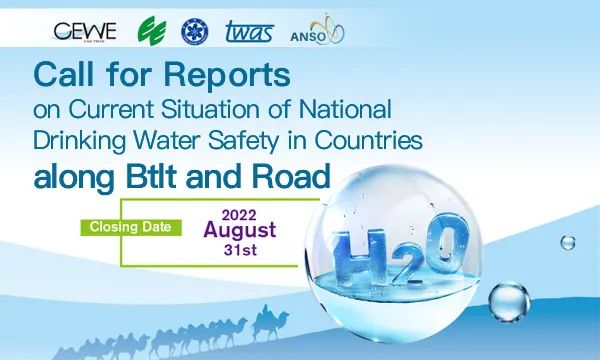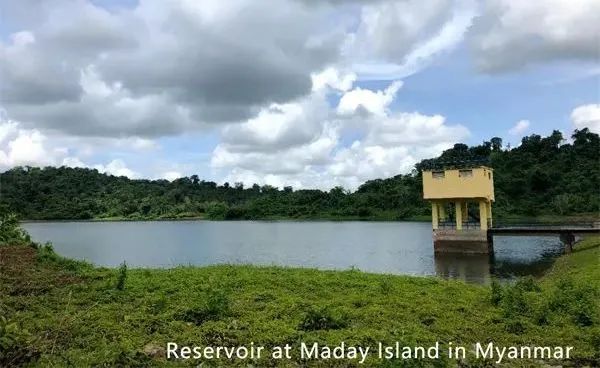
Call for Reports on Current Situation of National Drinking Water Safety in Countries along Belt and Road
1.Themes
The global drive of developing countries towards more industrialized economy has inadvertently led to several challenges, such as increased water pollution and lacks of water environment protection, which are threatening the overall drinking water safety that is closely related to public health and economic development goals. In response to the unique challenges encountered by developing countries, China has proposed the "Belt and Road" initiative based on its own experience as a developing country, which seeks to benefit people and countries along the Belt and Road through a series of effective measures to promote green, healthy and sustainable development, and build a community with a shared future for mankind.
In order to work jointly to improve drinking water quality and safety of developing countries, it is necessary to conduct a detailed survey to better understand local and regional problems and issues. To help the partnering institutions and project investors, we therefore invite you to submit reports for the current situation of drinking water safety in countries along the Belt and Road. The reports are aimed to cover: 1) the current situation of drinking water quality and safety in relevant countries; 2) the main problems faced and water usage; and 3) the demands in relevant technologies and international cooperation.
2. Requirements
(1) Each report will select one country along the Belt and Road for in-depth analysis. Countries include but are not limited to Cambodia, Myanmar, Bangladesh, Sri Lanka, Nepal, Iran, Kenya, Egypt, India, Indonesia, Brazil, Pakistan, Nigeria, Russia, Ethiopia, Philippines, South Africa, Israel, Thailand, Vietnam, Kazakhstan, and Uzbekistan.
(2) Report content: The report should investigate and analyze a country's 1) drinking water overview: including the overall status of water resources, major drinking water sources, water source pollution and protection; 2) drinking water safety supervision and legislation status, including relevant laws and policies, standards, operation mode of water supply, water supply and water quality supervision systems; 3) current status of water supply technologies and infrastructures, including the main treatment processes of surface water and groundwater, basic information of water treatment facilities and water distribution networks, current status of drinking water quality; 4) international assistance programs, related projects from governments or organizations; and 5) summary of the main problems and challenges in water source pollution, water supply technologies and management, the technical needs and international cooperation needs, etc..
The reporting framework and detailed content requirements are provided in Appendix I.
(3) Format:The manuscript should be organized around the theme, referring to the framework and content requirements. And all quoted text, data, pictures, etc., must be properly cited. The report could be submitted in either English or Chinese. There is no limitation on the number of words. The manuscript should be submitted in MS Word.
(4) The author's profile (name, date of birth, gender, nationality, institute, title, education status, email address, mobile phone, address, research direction) should be provided in the report.
3. Statements
(1) The manuscript should be non-confidential and the authorship should be non-controversial.
(2) The author has the copyright of the completed report, and CEWE keeps the right to use the accepted manuscript.
(3) CEWE has the right to edit the manuscript according to the overall needs of the book.
4. Benefits
All submissions will be carefully reviewed. Selected excellent articles will be awarded with certain cash prize (USD200-500). All accepted articles will become contributors to the final white paper. High-quality articles will also be recommended to influential Chinese journals.
5. Submission
Please submit the report in the form of word document before August 31, 2022 via e-mail to cas_twas@rcees.ac.cn.
The title of the email should be named as "Report on Current Situation of National Drinking Water Safety + country + name of author or organization".
We look forward to your submission and highly appreciate your contribution to the final White Paper of the Current Situation of National Drinking Water Safety in Countries along Belt and Road.
Appendix I

Appendix I Framework and Requirements (Including but not limited to the following contents)
Current Situation of National Drinking Water Safety
The basic information of the country, including geographic location, length of coastline, land area, water rate, population, per capita GDP, climate, water supply, etc.
1.Drinking water source
1.1.General situation of water resources
Requirements:The types of water sources in the country (precipitation, groundwater, surface water, etc.) and details of each type of water source. For example, amount of renewable water resources, annual freshwater withdrawals, renewable water resources per capita, rainfall, surface water flow, groundwater reserves, etc.
1.2.Main drinking water sources
Requirements:The main types of drinking water sources in rural and urban areas. Examples include piped water supply, tube wells, wells, rivers or reservoirs, rainwater harvesting, etc.
1.3.Water source pollution and protection
Requirements:The current situation of water pollution, including main pollution sources, pollutants, etc., and current protective measures against water pollution. It can be represented by a typical region or city.
2.Drinking water safety supervision
2.1.Relevant laws
Requirements:Strategies, policies, plans, and measures related to water resources and drinking water.
2.2.Relevant standards
Requirements:The current national standards and industry standards for drinking water.
2.3.Operation mode of water supply
Requirements:The water supply is provided by the state, local government, private sectors, franchise or other providers.
2.4.Supervision system
Requirements:The national water resources management and drinking water quality supervision institutions and systems.
3.Current situation of water supply technologies and infrastructures (mainly focusing on the water quality safety of urban and rural residents)
3.1.Main treatment processes of surface water and groundwater
Requirements:Processes and technologies for surface water and groundwater treatment. It can be represented by the process and technologies applied in a typical water treatment plant.
3.2.Basic information of water treatment facilities
Requirements:The basic situation of water treatment facilities such as centralized water supply and decentralized water supply in the country, which can be represented by typical regions or cities.
3.3.Basic information of water distribution networks
Requirements:Analyze the water distribution networks for centralized water supply and decentralized water supply in the country, which can be represented by typical regions or cities.
3.4.Current situation of drinking water quality
Requirements:Drinking water compliance status, which can be represented by typical regions or cities.
3.5.Special issues or typical situation in the country
4.International assistance program
Requirements:The assistance projects, aids, or loan funds, etc. from UN, ADB, USAID and other governments or organizations.
5.Summary
Requirements:(1) The country's main problems and challenges related to water security, including water pollution, water management, water treatment technology, etc.;(2) The country's technical needs and international cooperation needs.
6.References
References to published literature must be cited in the text as follows:
Li, G., Gregory, J., 2006. Flocculation and sedimentation of high-turbidity waters. Water Research 25 (9), 1137-1143.
References to books, reports and theses must be cited in the text as follows:
Author(s), date of publication, title of book, editor(s) name(s) if applicable, page numbers, name of publisher, and place of publication.